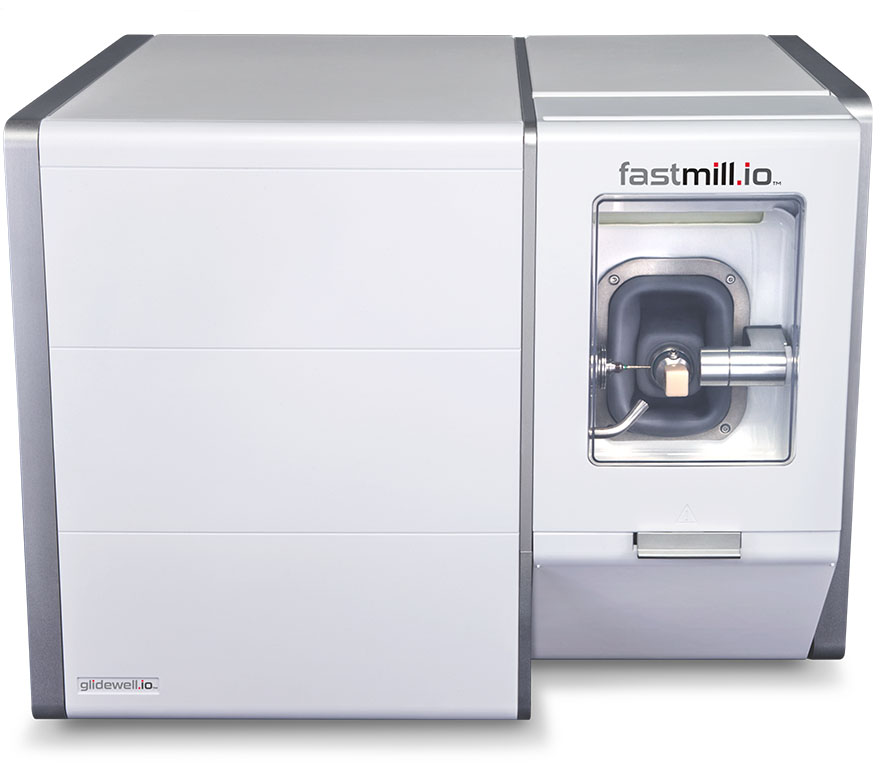We speak English, Spanish and Portuguese
We speak English, Spanish and Portuguese

At Inspirational Smiles in Cumming, GA, we prioritize treatments that respect your time without sacrificing clinical quality. One of the technologies we rely on is the Glidewell Fast Mill, a compact chairside milling system that enables a fully digital workflow for single-unit restorations. By combining in-office scanning, computer-aided design, and rapid milling, this approach shortens the appointment timeline while maintaining the precision required for long-term function.
Same-day crowns produced with the Glidewell Fast Mill remove several traditional steps that once required multiple visits and temporary restorations. The process centers on accuracy and repeatability: a digital impression replaces physical molds, a custom design is developed on-site, and the restoration is milled and finished in a single visit. The result is a permanent, custom-fitted crown that integrates with your bite and appearance more predictably than many older workflows.
Beyond convenience, the in-office mill supports a collaborative experience between clinician and patient. You can see and approve design choices, discuss material options, and have the restoration completed while you wait. For many patients this means less time spent in the chair overall and fewer appointments to coordinate with work and family obligations.
The Glidewell Fast Mill is part of a larger CAD/CAM ecosystem that begins with a high-resolution digital scan of the prepared tooth. Scans capture fine surface details and adjacent tooth relationships, which are essential for creating an accurate digital model. This eliminates distortion associated with traditional impression materials and provides a reliable starting point for the design phase.
Once the scan is complete, the restoration is designed using intuitive software that allows precise control over contours, occlusion, and contact points. Clinicians can adjust the anatomy to match surrounding teeth and to ensure an appropriate bite. These digital adjustments help minimize the need for later modifications and create a restoration that looks and functions like a natural tooth.
After the design is finalized, the Fast Mill transforms the digital file into a physical restoration by machining the selected block material to the exact specifications. Because the entire process occurs within the office, turnaround time is dramatically reduced. Technicians and clinicians work together immediately to complete finishing steps, shade characterization, and final polishing so the restoration can be placed the same day.

One of the strengths of chairside milling is the range of biocompatible materials available for same-day restorations. Contemporary ceramic and high-strength zirconia blocks offer excellent strength and color stability while allowing for lifelike translucency. Choosing the right material depends on the tooth’s location, functional demands, and aesthetic priorities, and your dentist will recommend the most suitable option during treatment planning.
Shade matching and surface characterization are important components of a natural-looking restoration. Digital shade selection tools, combined with experienced finishing techniques, help the final crown blend seamlessly with adjacent teeth. Polishing and glazing protocols are completed in-office to achieve the desired gloss and surface texture, reducing the contrast between the restoration and the natural dentition.
Because these materials are milled to precise dimensions, they provide consistent margins that support healthy gum tissue and simplify long-term maintenance. The optimized fit and smooth margins contribute to oral health by limiting areas where debris and bacteria can accumulate, which supports both function and aesthetic longevity.
Clinically, same-day crowns made with the Glidewell Fast Mill offer several practical advantages. The digital workflow reduces the chance of errors associated with impression transfer, and the precision milling produces tight marginal fit—two factors that are strongly associated with reduced postoperative sensitivity and lower risk of recurrent decay around restoration margins.
Another benefit is reduced provisionalization. Temporary crowns can introduce issues such as poor fit, fractures, or altered contacts; completing the final restoration in a single appointment avoids these potential complications. Patients often appreciate the reduced logistical burden of fewer visits, and clinicians can manage cases more effectively when fewer follow-ups are needed strictly for provisional replacement.
The predictability of a digital workflow also facilitates communication between the dental team and any outside lab partners when a restoration requires specialized finishing. Digital files can be exported for fabrication or archived for future reference, improving record-keeping and allowing consistent outcomes if revisions are ever necessary.
Your appointment will begin with a focused evaluation and any necessary preparation of the affected tooth. After local anesthesia is administered, the tooth is shaped to receive the restoration. Using an intraoral scanner, a high-fidelity digital impression is taken to document the prepared tooth and its relationship to neighboring and opposing teeth.
Design is collaborative: the dentist reviews the proposed anatomy and occlusal relationships on the screen and may make adjustments to ensure proper contact, function, and aesthetics. Once the design is finalized, the milling cycle begins. Milling times vary by material and design complexity but are typically completed within the same appointment. While the restoration is milled, the team prepares the area and discusses aftercare instructions.
After milling, the crown undergoes finishing steps such as trimming, staining, glazing, and polishing before being tried in and validated for fit and bite. The dentist will ensure the restoration seats properly, makes any minor adjustments, and then bonds the crown using the appropriate adhesive protocol. A final check confirms occlusion and patient comfort before concluding the visit.
Care for a same-day crown is similar to that for any fixed restoration: maintain routine brushing and flossing, attend regular dental checkups, and report any unusual sensitivity or changes promptly. Proper oral hygiene and periodic professional cleanings help preserve the restoration and the health of surrounding tissues. Avoiding habits that place excessive force on a single tooth—such as chewing ice or using teeth as tools—also protects the restoration over time.
Routine examinations allow the dentist to monitor wear patterns, contact integrity, and the health of the margins. If a future adjustment or repair becomes necessary, the digital records and stored design files can expedite the process, helping the clinical team reproduce or modify the restoration efficiently.
Choosing a same-day workflow does not change the importance of preventive care; instead, it complements a preventive approach by delivering high-quality restorations with minimal disruption to your schedule. When combined with good daily habits and regular professional oversight, same-day crowns can be a dependable component of a long-term oral health strategy.
In summary, the Glidewell Fast Mill supports efficient, precise same-day crown treatment that fits well into modern dental practice. If you’d like to learn more about how this technology is used in our office or whether a same-day restoration is a good option for you, please contact us for more information.


The Glidewell Fast Mill is an in-office milling system used to fabricate dental restorations from digital designs. It integrates with CAD/CAM software to convert scanned tooth data into precise ceramic or composite restorations. The system is designed to support same-day workflows by producing crowns, onlays and other prosthetics without sending impressions to an external lab.
Because the mill works directly from digital designs, it reduces manual steps in the restoration process and helps maintain consistent production quality. Clinicians can control material selection, milling parameters and finishing steps to meet the clinical requirements for strength and esthetics. The Fast Mill is one component of a complete digital restorative workflow that includes intraoral scanning and chairside design.
The process begins with an intraoral scan that captures the prepared tooth and surrounding bite, creating an accurate digital model. Using CAD software, the clinician designs the crown while the patient waits, refining contours, contacts and occlusion before sending the design to the mill. The Glidewell Fast Mill then mills the restoration from the selected material and the team completes finishing steps such as staining, glazing and polishing.
After try-in and minor adjustments, the crown is checked for fit and occlusion, then permanently seated during the same visit. This workflow removes the need for a temporary crown and a separate delivery appointment, streamlining treatment for single-unit restorations. The approach relies on careful planning and communication between the clinician and dental team to ensure predictable results.
The Glidewell Fast Mill is capable of producing a variety of single-unit and short-span restorations, including crowns, inlays, onlays and some implant abutment crowns. It is commonly used for ceramic materials such as zirconia and lithium disilicate as well as provisional materials for temporaries. The system supports a broad clinical range from restorative repairs to esthetic crown replacements when indicated.
For more complex restorations like full-arch prostheses or extensive multi-unit implant frameworks, a laboratory workflow or specialized milling equipment may be preferable. The decision about which restorations to mill in-office is based on material requirements, case complexity and the clinician’s treatment plan. In many typical restorative scenarios, the Fast Mill offers an efficient in-office option that complements laboratory services.
Same-day crowns milled from high-strength ceramics such as monolithic zirconia or lithium disilicate can provide excellent durability and wear resistance for posterior and anterior applications when properly selected and finished. These materials are engineered to withstand normal chewing forces and, when finished with appropriate staining and glazing, can achieve a natural appearance. The milling process produces restorations with precise marginal integrity, which supports long-term function.
Achieving optimal esthetics also depends on surface characterization, glazing and how well the restoration matches the patient’s adjacent teeth. The clinician can adjust translucency, color and surface texture during the finishing stage to create a harmonious result. With careful material selection and laboratory-grade finishing techniques applied chairside, same-day crowns can combine strength with pleasing esthetic outcomes.
Digital scanning replaces traditional impressions by capturing a detailed three-dimensional image of the prepared tooth and occlusion, which becomes the foundation for the CAD design. High-quality scans improve the accuracy of margins, contacts and opposing relationships, reducing the need for extensive chairside adjustments after milling. Digital files also allow clinicians to preview the restoration, make design refinements and document case details efficiently.
Because the digital workflow is repeatable and easily archived, it supports predictable fabrication and future refinements if needed. Scans can be shared with external labs or saved for reference, improving communication and continuity of care. Overall, intraoral scanning enhances speed, accuracy and patient comfort in the same-day crown process.
Same-day crowns reduce the number of appointments patients must attend by combining preparation, design, milling and placement into a single visit, which is convenient for busy schedules and minimizes time spent with a temporary restoration. This approach also eliminates the need for physical impressions in many cases, improving patient comfort and streamlining clinical efficiency. When performed chairside, restorations can be adjusted and completed immediately to address fit and esthetic goals.
At our Cumming, GA office, the in-house digital workflow supports close coordination between the clinician and dental team to deliver personalized results. Patients benefit from consistent communication during the appointment and the ability to see design options before milling. The practice emphasizes precise fit, conservative preparation and attention to esthetic detail to help achieve long-lasting outcomes.
A same-day crown appointment using an integrated digital workflow commonly takes a few hours from start to finish, though exact time varies by case complexity and the number of restorations being completed. Key steps include digital scanning, CAD design, milling, finishing and final placement, and each step requires careful attention to detail. Scheduling protocols and team coordination help keep the appointment efficient while allowing time for any necessary adjustments.
Certain factors such as difficult access, additional tooth preparation, or extensive occlusal adjustments can extend the appointment time, while straightforward single-unit cases are often completed more quickly. The clinician evaluates each patient’s needs during the consultation to set appropriate expectations for chair time. Efficient in-office workflows and experienced staff help ensure a smooth same-day experience for most standard restorative cases.
Precision begins with high-quality intraoral scans and accurate tooth preparation to provide a reliable digital foundation for the CAD design. The practice uses advanced design software to control margin accuracy, contact points and occlusal anatomy before milling, which reduces the need for large adjustments after fabrication. After milling, careful finishing, characterization and polishing are performed to refine fit and surface detail.
At the try-in stage, the clinician verifies seating, proximal contacts and occlusion, making any minor adjustments to ensure comfort and proper function. Final cementation follows only after occlusion is balanced and soft tissue health is confirmed. This stepwise verification process helps achieve a stable, well-fitting restoration that integrates with the patient’s existing dentition.
Precision begins with high-quality intraoral scans and accurate tooth preparation to provide a reliable digital foundation for the CAD design. The practice uses advanced design software to control margin accuracy, contact points and occlusal anatomy before milling, which reduces the need for large adjustments after fabrication. After milling, careful finishing, characterization and polishing are performed to refine fit and surface detail.
At the try-in stage, the clinician verifies seating, proximal contacts and occlusion, making any minor adjustments to ensure comfort and proper function. Final cementation follows only after occlusion is balanced and soft tissue health is confirmed. This stepwise verification process helps achieve a stable, well-fitting restoration that integrates with the patient’s existing dentition.
Same-day crown workflows are suitable for many single-tooth implant restorations and straightforward crown cases, particularly when the implant position and healing are stable. Digital impressions and custom abutment designs can be integrated into the in-office workflow to create implant crowns that fit precisely. However, complex implant cases, full-arch reconstructions or situations requiring extensive laboratory customization may still benefit from a laboratory-based or staged approach.
The clinician evaluates factors such as implant angulation, soft tissue management and occlusal demands when determining whether an in-office mill is appropriate. Collaboration with surgical specialists and, when necessary, lab partners ensures the chosen workflow meets long-term functional and esthetic objectives. Patient safety and predictable results guide the treatment planning decision for each individual case.
Patients should maintain good oral hygiene practices by brushing twice daily with a fluoride toothpaste and flossing once daily to protect the crown margins and surrounding gum tissue. Avoiding excessive force on the restoration, such as opening packages with teeth or chewing very hard objects, helps preserve the crown’s integrity. Regular dental checkups allow the clinician to monitor the crown, check occlusion and address any emerging concerns promptly.
If a patient has a history of clenching or grinding, the clinician may recommend a protective nightguard to reduce wear and prevent damage to the restoration. Any sensations of looseness, persistent sensitivity or changes in bite should be reported to the office so the team can evaluate the crown and surrounding tissues. Proper home care combined with routine professional maintenance supports long-term success of the restoration at Inspirational Smiles.

Looking to schedule your next dental visit or learn more about our services?
Getting in touch with Inspirational Smiles is simple! Our caring team is ready to help with appointment scheduling, questions about treatments, or any concerns you may have. You can call us or use our easy online contact form—whatever works best for you.
Take the first step toward a healthier, more confident smile today and experience the difference that personalized, compassionate dental care can make.